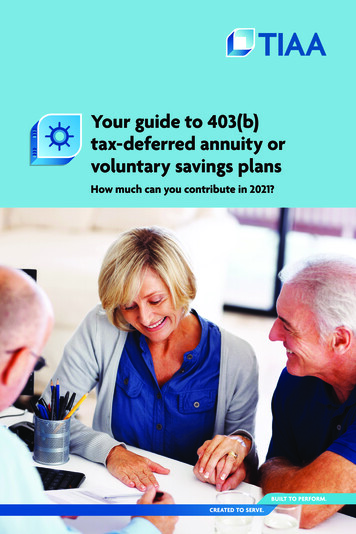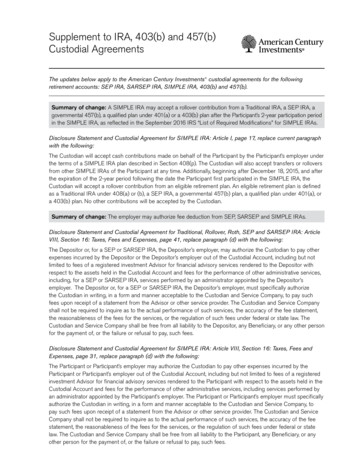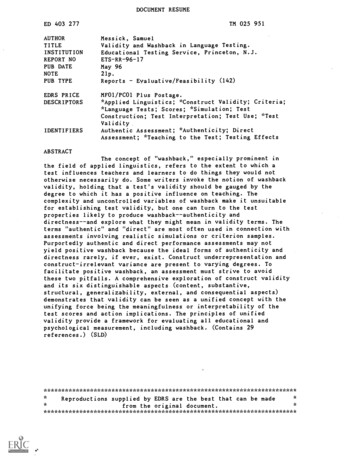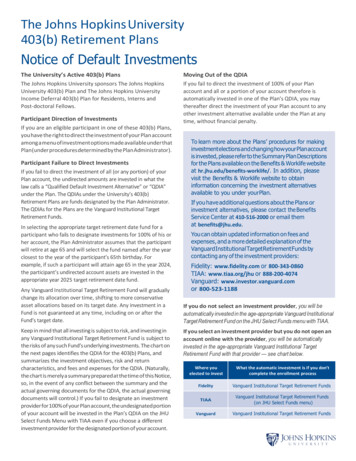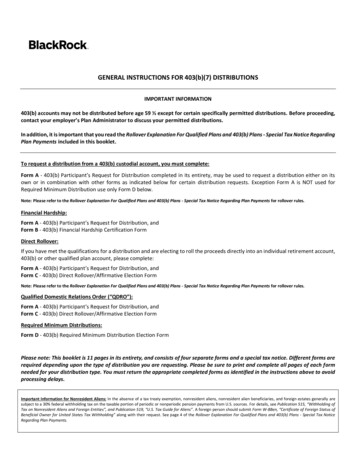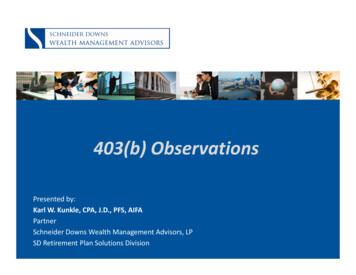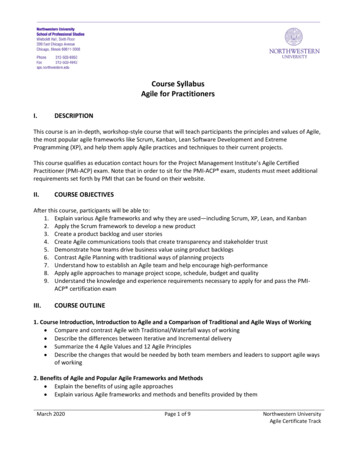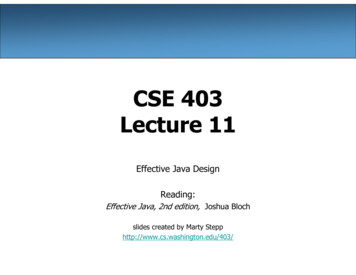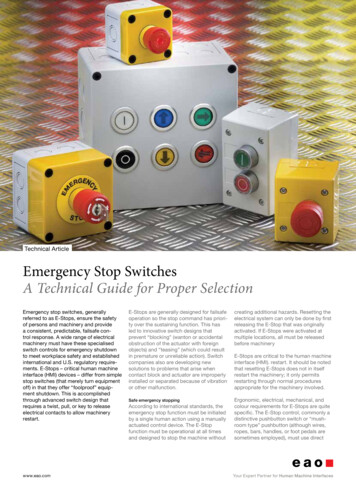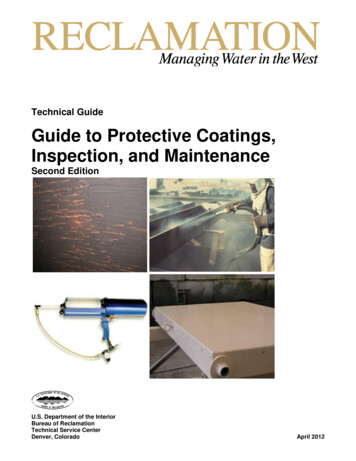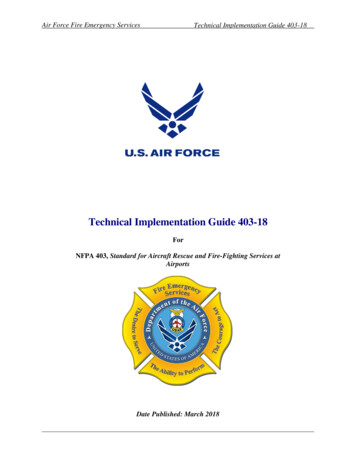
Transcription
Air Force Fire Emergency ServicesTechnical Implementation Guide 403-18Technical Implementation Guide 403-18ForNFPA 403, Standard for Aircraft Rescue and Fire-Fighting Services atAirportsDate Published: March 2018
Air Force Fire Emergency ServicesTechnical Implementation Guide 403-18PrefaceIn accordance with established policies and procedures, AFCEC/CXF conducted acomprehensive line item review of NFPA 403, Standard for Aircraft Rescue and FireFighting Services at Airports (2018 Edition). This Technical Implementation Guide (TIG)provides clarification and deviation approvals authorized by the Authority Having Jurisdiction,Director of Civil Engineers. Line items not addressed in this TIG are implemented as written. ThisTIG does not apply for use during contingency, humanitarian relief, or wartime operations.Consult War Mobilizations Plan (WMP) 1, Annex S, for staffing and vehicle requirements.The left hand column lists the NFPA line items which correspond to a clarification or deviation onthe right hand column.All DET Fire Emergency Services functionals have coordinated on this TIG. Correspondence inthis regard is on file at AFCEC/CXF, Tyndall AFB FL.TIMOTHY W. RICKARD, Jr, CMSgt, USAFThe Air Force Fire Chief (Interim)This TIG includes one attachment:1. Aircraft Rescue and Fire Fighting Response Guide
Air Force Fire Emergency ServicesTechnical Implementation Guide 403-18NFPA 403, 2018 EditionAir Force Implementation MatrixChapter 1 – Administration Adopt as written with the following clarifications.1.1* Scope.This Technical Implementation Guide (TIG) provides Air Forceclarifications or deviations to National Fire Protection Association(NFPA) Standard 403, Aircraft Rescue and Fire Fighting Servicesat Airports (2018 Edition).2.3.2 Other Publications:Clarification: Added the following references:2.3.2.1 Department of Defense Instruction (DoDI) 6055.06Fire and Emergency Services Program2.3.2.2 Air Force Instruction (AFI) 32-2001, The Fire EmergencyServices Program2.3.2.3 Allowance Source Code (ASC) 010, Vehicle Fleet(Registered) All MAJCOM Common2.3.2.4 Air Force Manpower Standard, FireEmergency Services Flight 44EF002.3.2.5 Applicable Air Force Technical Orders3.2.2* Authority HavingClarification: The Director of Civil Engineers is the authorityJurisdiction (AHJ)having jurisdiction (AHJ) for Air Force FES deviations.4.3.1 and Table 4.3.1Clarification: ASC 010 provides the authorization for a corevehicle set that includes ARFF, structural, rescue, andfirefighting support vehicles based on the mission assignedaircraft for an installation as codified by the Vehicle Validationand Realignment Plan (HQ USAF/A7C letter, updated 12 Sep12) and AFI 32-2001.4.3.2*Clarification: The Air Force instituted six vehicle sets. Thesesets provide vehicles of various capacities to meet the minimumaggregate agent requirements established by N F P A , as outlinedin paragraph 5.3.1 of this document.5.3.1* and Tables 5.3.1(a) and Clarification: ASC 010 provides the authorization for a core5.3.1(b)vehicle set that includes ARFF, structural, rescue, andfirefighting support vehicles based on the mission assignedaircraft for an installation. The ARFF sets are a combination of500, 1000, 1500, 3000 or 3300-gallon ARFF vehicles provided in6 sets based on specific agent calculations for aircraft types asdefined in ASC 010.USAF Set 1 meets the requirements of NFPA categories 1 – 4.USAF Set 2 meets the requirements of NFPA categories 5.USAF Set 3 meets the requirements of NFPA category 6-7.USAF Set 4 meets the requirements of NFPA category 8.USAF Set 5 meets the requirements of NFPA category 9.USAF Set 6 meets the requirements of NFPA category 10.Note: Set 6 is designed for the C5-A/B and 747-8i aircraft.Utilizing NFPA 403 Annex B computations of Q1 Q2 Q3, thegallonage requirement for the C-5A/B and 747-8i aircraft is 12,626gallons of agent.
Air Force Fire Emergency ServicesTechnical Implementation Guide 403-18Clarification: USAF Set 1 meets the requirements of NFPA6.1.1* and Table 6.1.1Categories 1 – 4.Core Vehicle Set #1 – Vehicle requirements for installations withassigned aircraft with an overall fuselage length of 30 feet up tobut not including 78 feet and a fuselage width of up to but notincluding 13 feet.The Air Force aircraft protected by this vehicle set are the: T-37B(Tandem), BQM-34, RQ-1A/B, T-38A, AT-38B/C, MQM-107,T-6A, UV-18, QF-4, CV-22, UH-1N, C-38A, A-10 & OA-10, F16C/D, T-1A, C-21A, RQ-4A, C-12, F-15A/B/C/D, F-15E, F117A, F-22A and F-35A/B/C.Core Vehicle Set #1P-22/24 – Structural PumperP-22/24 – Structural Pumper or P-33 75’ QuintP-30 – Rescue VehicleP-18/26 – Water TankerP-19 – Crash Truck (1,500 gallons)P-34 – Rapid Intervention Vehicle (500 gallons)P-34 – Rapid Intervention Vehicle (500 gallons)P-31 – HazMat VehicleClarification: USAF Set 2 meets the requirements of NFPACategory 5.Core Vehicle Set #2 – Vehicle requirements for installations withassigned aircraft with an overall fuselage length of 78 feet up tobut not including 90 feet and a fuselage width of up to but notincluding 13 feet.The Air Force aircraft protected by this vehicle set is the:C-20A/B/C/H.Core Vehicle Set #2P-22/24 – Structural PumperP-22/24 – Structural Pumper or P-33 75’ QuintP-30 – Rescue VehicleP-18/26 – Water TankerP-23 – Crash Truck (3,000 gallons)P-34 – Rapid Intervention Vehicle (500 gallons)P-34 – Rapid Intervention Vehicle (500 gallons)P-31 – HazMat Vehicle
Air Force Fire Emergency ServicesTechnical Implementation Guide 403-18Clarification: USAF Set 3 meets the requirements of NFPACategories 6 – 7.Core Vehicle Set #3 – Vehicle requirements for installations withassigned aircraft with an overall fuselage length of 90 feet up tobut not including 160 feet and a fuselage width of up to but notincluding 16 feet 4 inches.The Air Force aircraft protected by this vehicle set are the:C-9A/C (DC-9), C-40C (737), EC-130E, T-43A (737), WC130H, HC-130P/N, MC-130P, AC-130H/U, C-130 E/H/J/J-30,EC-130H, LC-130, MC-130E/H, C-37A, MH-53J/M, C-32A(757), E-8C (707), E-3B (707), C-22B and RC-135U/V/W (707).Core Vehicle Set #3P-22/24 – Structural PumperP-22/24 – Structural Pumper or P-33 75’ QuintP-30 – Rescue VehicleP-18/26 – Water TankerP-23 – Crash Truck (3,000 gallons)P-19 – Crash Truck (1,500 gallons)P-34 – Rapid Intervention Vehicle (500 gallons)P-31 – HazMat VehicleClarification: USAF Set 4 meets the requirements of NFPACategory 8.Core Vehicle Set #4 – Vehicle requirements for installations withassigned aircraft with an overall fuselage length of 160 feet up tobut not including 200 feet and a fuselage width of up to but notincluding 23 feet.The Air Force aircraft protected by this vehicle set are the: C-17A,B-1B, B-2, B-52H, KC-135 (707) and KC-46 (767).Core Vehicle Set #4P-22/24 – Structural PumperP-22/24 – Structural Pumper or P-33 75’ QuintP-30 – Rescue VehicleP-18/26 – Water TankerP-23 – Crash Truck (3,000 gallons)P-23 – Crash Truck (3,000 gallons)P-19 – Crash Truck (1,500 gallons)P-34 – Rapid Intervention Vehicle (500 gallons)P-31 – HazMat VehicleClarification: USAF Set 5 meets the requirements of NFPACategory 9.Core Vehicle Set #5 – Vehicle requirements for installations withassigned aircraft with an overall fuselage length of 200 feet up to
Air Force Fire Emergency ServicesTechnical Implementation Guide 403-18but not including 250 feet and a fuselage width of up to but notincluding 23 feet.The Air Force aircraft protected by this vehicle set are the: E-4B(747), VC-25 (747) and KC-10A (DC-10).Core Vehicle Set #5P-22/24 – Structural PumperP-22/24 – Structural Pumper or P-33 75’ QuintP-30 – Rescue VehicleP-18/26 – Water TankerP-23 – Crash Truck (3,000 gallons)P-23 – Crash Truck (3,000 gallons)P-23 – Crash Truck (3,000 gallons)P-34 – Rapid Intervention Vehicle (500 gallons)P-34 – Rapid Intervention Vehicle (500 gallons)P-31 – HazMat VehicleClarification: USAF Set 6 meets the NFPA agentrequirements for the C-5A/B using the methodology in NFPA 403Annex B.Core Vehicle Set #6 – Vehicle requirements for installations withassigned aircraft with an overall fuselage length of 250 feet up tobut not including 295 feet and a fuselage width of up to but notincluding 25 feet.The Air Force aircraft protected by this vehicle set are the: C 5A/B and 747-8i.8.1.2.1 and Table 8.1.2.18.1.2.2.29.1.3* Response TimeCore Vehicle Set #5P-22/24 – Structural PumperP-22/24 – Structural Pumper or P-33 75’ QuintP-30 – Rescue VehicleP-18/26 – Water TankerP-23 – Crash Truck (3,000 gallons)P-23 – Crash Truck (3,000 gallons)P-23 – Crash Truck (3,000 gallons)P-23 – Crash Truck (3,000 gallons)P-34 – Rapid Intervention Vehicle (500 gallons)P-34 – Rapid Intervention Vehicle (500 gallons)P-31 – HazMat VehicleClarification: Refer to AFI 32-2001 Levels of Service forapplicable risk acceptance and management approach minimumstaffing requirementsClarification: Refer to AFI 32-2001 Levels of Service forapplicable risk acceptance and management approach minimumstaffing requirementsClarification: DoDI 6055.06 specifies response time criteria.
Air Force Aircraft Rescue and Fire Fighting Response GuideAFCEC 403-18AIR FORCEFIRE EMERGENCY SERVICESAIRCRAFT RESCUEANDFIRE FIGHTINGRESPONSE GUIDEMarch 2018AFCEC/CXFPage 2
Air Force Aircraft Rescue and Fire Fighting Response GuideAFCEC 403-18TABLE OF craft Rescue and Fire Fighting (ARFF) Response GuidanceSection 1 – Airfield/Runway LayoutCritical Rescue and Fire Fighting Access AreaSection 2 – Response TimeARFF Response Time RequirementsConcept of ARFF Response TimeMeasurement of ARFF Response TimeSection 3 – Staffing and Vehicle RequirementsStaffing RequirementsVehicle RequirementsRelationship of Staffing and Vehicles to Standards of Response CoverageSection 4 – Risk Assessment ProcessRisk ManagementRisk Assessment ConditionsSample Fire Protection Risk Management Assessment ExhibitSection 5 – Air Show SafetySection 6 – Equivalent Fire Fighting CapabilitySupersedes: This edition of the Air Force Aircraft Rescue and Fire Fighting Response Guidesupersedes all previous editions.AFCEC/CXFPage 3
Air Force Aircraft Rescue and Fire Fighting Response GuideAFCEC 403-18INTRODUCTION1. Purpose. The purpose of this guide is to clarify the Air Force (AF) implementation ofDepartment of Defense Instruction (DoDI) 6055.06, Department of Defense Fire and EmergencyServices Program (21 December 2006) and National Fire Protection Association (NFPA) Standard403, Aircraft Rescue and Fire Fighting Services at Airports (2018 Edition), relative to aircraftrescue and fire fighting (ARFF) operations. This guide provides a template for Air ForceInstallation and Mission Support Center (AFIMSC) Detachments (Dets) and base-level senior fireofficials (SFOs) to utilize during assessments and to effectively communicate ARFF capabilitiesto leadership. Furthermore, it consolidates existing AF and applicable National Fire ProtectionAssociation (NFPA) criteria pertaining to response criteria, staffing and vehicle requirements, andit outlines the use of a risk assessment process. This guide also contains a sample fire protectionrisk management assessment model.2. Background. DoDI 6055.06 contains ARFF response criteria pertaining to response time, firefighting vehicle agent requirements, and ARFF fire ground staffing. The AF uses Air ForceInstruction (AFI) 32-2001, Fire Emergency Services Program, Allowance Source Code (ASC)010, Vehicle Fleet (Registered) All MAJCOM Common, and Air Force Manpower Standard(AFMS), Fire Protection Flight 44EF00, as the means to identify service specific requirements toimplement DoDI 6055.6. The AF ARFF vehicle sets listed in ASC 010 have been adjusted byimplementation of the Vehicle Validation and Realignment Plan (VVRP) (Updated 12 September2012) codified in AFI 32-2001 and are consistent with NFPA 403 airport categories, agents, andvehicle requirements.3. Discussion. The key to an effective ARFF program is having the ability to deliver sufficientfire fighting agent within a limited amount of time. The goal of the AF ARFF program is toprovide protection for aircrews, passengers, aircraft, and on-board weapons, while preventingand/or reducing collateral damage to any exposed property. A thorough understanding of ARFFresponse criteria, vehicle capabilities, and staffing requirements will enable SFOs to effectivelyexecute DoD and AF implementation instructions. SFOs are responsible for utilizing availableresources to the fullest extent possible and must notify senior leadership, using a Risk Management(RM) process, when fire protection capabilities fall below mission requirements. Acomprehensive fire risk management plan, supported by documented RM assessments, providesinformation for both the MAJCOM CE and wing leadership to make key risk-acceptancedecisions.4. Aircraft Rescue and Fire Fighting Response Guidance. Several factors must be consideredwhen determining ARFF response criteria. These factors include response time for announcedand unannounced aircraft emergencies, staffing and vehicle requirements, and the use of a riskassessment process.AFCEC/CXFPage 1
Air Force Aircraft Rescue and Fire Fighting Response GuideAFCEC 403-18SECTION 1 – AIRFIELD/RUNWAY LAYOUT5. Critical Rescue and Fire Fighting Access Area.5.1. DoDI 6055.06 incorporates NFPA 403 concepts and requirements as the baseline for ARFFresponse criteria. This criteria identifies a specific area of an airfield where the majority of aircraftflight or ground related fire incidents have historically occurred. This area is known as the CriticalRescue and Fire Fighting Access Area (CRFFAA). The CRFFAA is defined as the rectangulararea surrounding any runway within which most aircraft accidents can be expected to occur onairports. Its width extends 500 feet from each side of the runway centerline, and its length is 3,300feet beyond each runway end.5.2. The CRFFAA contains an area known as the Rapid Response Area (RRA). The RRA isdefined as a
23.08.2018 · (NFPA) Standard 403, Aircraft Rescue and Fire Fighting Services at Airports (2018 Edition). 2 . P-22/24 – Structural Pumper or P-33 75’ Quint P-30 – Rescue Vehicle . P-18/26 – Water Tanker . P-23 – Crash Truck (3,000 gallons) P-19 – Crash Truck (1,500 gallons) P-34 – Rapid Intervention Vehicle (500 gallons) P-31 – HazMat Vehicle . Clarification: USAF Set 4 meets the .
